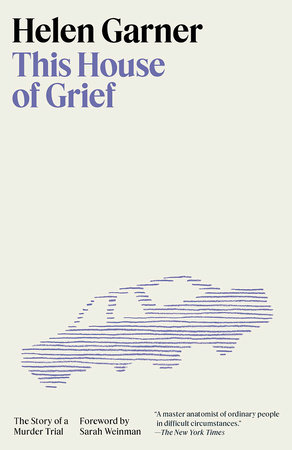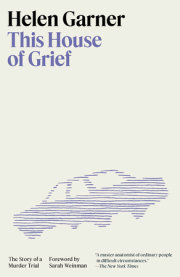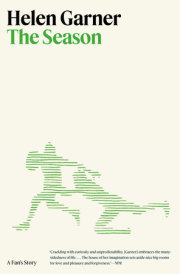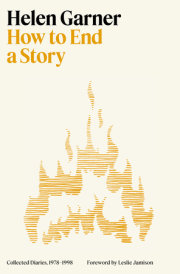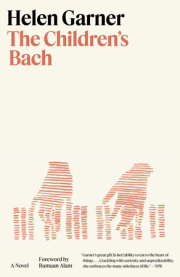Once there was a hard-working bloke who lived in a small Victorian country town with his wife and their three young sons. They battled along on his cleaner’s wage, slowly building themselves a bigger house. One day, out of the blue, his wife told him that she was no longer in love with him. She did not want to go on with the marriage. She asked him to move out. The kids would live with her, she said, and he could see them whenever he liked. She urged him to take anything he wanted from the house. The only thing she asked for, and got, was the newer of their two cars.
The sad husband picked up his pillow and went to live with his widowed father, several streets away. Before long his wife was seen keeping company with the concreter they had hired to pour the slab for the new house. The tradesman was a born-again Christian with several kids and his own broken marriage. Soon the separated wife began to accompany him to his church. Next, the husband spotted the concreter driving around town in the car that he had slaved to buy.
Up to this point you could tell the story as a country-and-western song, a rueful tale of love betrayed, a little bit whiny, a little bit sweet.
But ten months later, just after dark on a September evening in 2005, while the discarded husband was driving his sons back to their mother from a Father’s Day outing, his old white Commodore swerved off the highway, barely five minutes from home, and plunged into a dam. He freed himself from the car and swam to the bank. The car sank to the bottom, and all the children drowned.
I saw it on the TV news. Night. Low foliage. Water, misty and black. Blurred lights, a chopper. Men in hi-vis and helmets. Something very bad here. Something frightful.
Oh Lord, let this be an accident.
Anyone can see the place where the children died. You drive south-west out of Melbourne on the Princes Highway, the road that encircles the continent. You bypass Geelong, resist the call of the Surf Coast turn-off, and keep going inland in the direction of Colac, on the great volcanic plain that stretches across south-western Victoria.
In August 2006, after a magistrate at a Geelong hearing had committed Robert Farquharson to stand trial on three charges of murder, I headed out that way one Sunday morning, with an old friend to keep me company. Her husband had recently left her. Her hair was dyed a defiant red, but she had that racked look, hollow with sadness. We were women in our sixties. Each of us had found it in herself to endure—but also to inflict—the pain and humiliation of divorce.
It was a spring day. We passed Geelong and were soon flying along between paddocks yellow with capeweed, their fence lines marked by the occasional windbreak of dark cypresses. Across the huge sky sailed flat-bottomed clouds of brilliant white. My companion and I had spent years of our childhoods in this region. We were familiar with its melancholy beauty, the grand, smooth sweeps of its terrain. Rolling west along the two-lane highway, we opened the windows and let the air stream through.
Four or five kilometres short of Winchelsea we spotted ahead of us the long, leisurely rise of a railway overpass. Was this the place? Talk ceased. We cruised up the man-made hill. From the top we looked down and saw, ahead and to the right of the road, a body of tan water in a paddock—not the business-like square of a farm dam but oval-shaped, feminine, like an elongated tear drop, thinly fringed with small trees. Its southern bank lay parallel with the northern edge of the highway, twenty or thirty metres from the bitumen. I had imagined the trajectory of Farquharson’s car as a simple drift off the left side of the highway; but to plunge into this body of water on the wrong side of the road, the car would have had to veer over the centre white line and cut across the east-bound lane with its oncoming traffic. As we sped down the Winchelsea side of the overpass, forcing ourselves to keep glancing to the right, we saw little white crosses, three of them, knee-deep in grass between the road and the fence. We flew past, as if we did not have the right to stop.
We had a vague idea that six thousand people lived in Winchelsea, but a sign at the entrance to the township gave its population as 1180, and by the time we had rolled down the dip to the bluestone bridge that spanned the Winchelsea River, then up the other side and past a row of shops and a primary school, the outer limits of the town were already in view. In a place this size, everyone would know your business.
A mile or so beyond the township, we turned down a side road and found a grassy spot where we could eat our sandwiches. We felt awkward, almost guilty. Why had we come? We spoke in low voices, avoiding each other’s eye, staring out over the sunny paddocks.
Do you think the story he told the police could be true—that he had a coughing fit and blacked out at the wheel? There is such a thing. It’s called cough syncope. The ex-wife swore at the committal hearing that he loved his boys. So? Since when has loving someone meant you would never want to kill them? She said it was a tragic accident—that he wouldn’t have hurt a hair on their heads. His whole family is backing him. In court he had a sister on either side and an ironed hanky in his hand. Even the ex-wife’s family said they didn’t blame him. But wasn’t there weird police evidence? The tracks his car had left? And didn’t he bolt? Yes. He left the kids in the sinking car, and hitched a ride to his ex-wife’s place. He looked massive in the photos—is he a big bloke? No, he was small and stumpy. With puffy eyes. Did you see him close up at the committal? Yes, he held the door open for me. Did he smile at you? He tried to. Maybe he’s a psychopath—isn’t that how they get to you? By being charming? He didn’t look charming. He looked terrible. Wretched. What—you felt sorry for him? Well…I don’t know about sorry. I don’t know what I was expecting, but he was ordinary. A man.
The cemetery, on the outskirts of Winchelsea, was a couple of acres of wide, sloping ground, open to the sky. Nobody else was around. We wandered up and down the rows. No Farquharsons. Perhaps the family came from another town? But as we plodded up the path to the car, I glanced past a clump of shrubbery and saw a tall headstone of polished granite that bore a long surname and three medallion-shaped photos. We approached with reluctant steps.
Some AFL fan had poked into the dirt beside the grave an Essendon pinwheel on a wand. Its curly plastic blades whizzed merrily. In the upper corners of the headstone were etched the Essendon Football Club insignia and a golden Bob the Builder. The little boys faced the world with frank good cheer, their fair hair neatly clipped, their eyes bright. Jai, Tyler, Bailey. Much loved and cherished children of Robert and Cindy…In God’s hands till we meet again. I studied it with a sort of dread. Often, in the seven years to come, I would regret that I had not simply blessed them that day and walked away. In the mown grass sprouted hundreds of tiny pink flowers. We picked handfuls and laid them on the grave, but the breeze kept blowing them away. Every twig, every pebble we tried to weight them with was too light to resist the steady rushing of the spring wind.
A year passed between the committal hearing and the trial. When Farquharson’s name came up in conversation, people shuddered. Tears would spring to women’s eyes. Everyone had a view. The coughing fit story provoked incredulity and scorn. The general feeling was that a man like Farquharson could not tolerate the loss of control he experienced when his wife ended the marriage. Again and again people came up with this explanation. Yes, that must have been it—he couldn’t stand to lose control of his family. Either that, or he was evil. Pure evil. I don’t get these guys, said a feminist lawyer. Okay, so the wife dumps them. Men don’t have biological clocks. Why can’t they just find a new girlfriend and have more kids? Why do they have to kill everyone? Whether he did it on purpose or not, said an older woman, a Christian, how is he going to atone? Countless men declared in anger and distress that it couldn’t possibly have been an accident; that a loving father would never leave the car and swim away. He would fight to save his kids, and, if he failed, he would go to the bottom with them. Rare were the ones who, after making such a declaration, paused and added in a lower voice, ‘At least, that’s what I hope I’d do.’
When I said I wanted to write about the trial, people looked at me in silence, with an expression I could not read.
On 20 August 2007, two years after his car went into the dam, Robert Farquharson’s trial opened in the Supreme Court of Victoria. As a freelance journalist and curious citizen, I had spent many days, solitary and absorbed, in the courtrooms of that nineteenth-century pile in central Melbourne, with its dome and its paved inner yards and its handsome façade along William and Lonsdale Streets. I knew my way around it and how to conduct myself inside its formal spaces, but I could never approach its street entrance without a surge of adrenalin and a secret feeling of awe.
This time I had brought with me a close friend’s daughter, a pale, quiet sixteen-year-old with white-blonde hair and braces on her teeth, dressed in jeans and a sky-blue hoodie. Her name was Louise. She was in her gap year. I would come to be grateful for her company, and for her precocious intelligence. We squeezed into the press seats of Court Three with a gang of cheerful journalists. From the tone of their gossip, Farquharson was already hung, drawn and quartered.
The court was beautiful. It had a soaring ceiling, pale plaster walls, and fittings of dark, ponderous timber; but, like all the courtrooms in that grand old building, it was cramped, and awkward to move around in. The dock ran along the rear wall, and in it, behind a red velvet rope, sat Robert Farquharson in a glaring white shirt with a stiff collar and tie. He had entered a free man, but now his bail had ended and he was in custody. Though the room was packed with his supporters, he looked scared, and small, and terribly lonely.
Jeremy Rapke QC, Acting Chief Crown Prosecutor and soon to be appointed Director of Public Prosecutions, had appeared for the Crown at Farquharson’s committal hearing. He was a lean, contained-looking man, with a clipped grey beard and a mouth that cut across his face on a severe slant, like that of someone who spent his days listening to bullshit.
‘Wow,’ hissed Louise. ‘He looks like a falcon.’
Lawyers I knew said he was formidable in trials, and at the committal he had been enthralling to watch: he did not seem to exert himself, and he spoke sparingly, in a low, courteous voice, as if his words were only the upper layer of some more crucial process that was going on inside his head. But his final submission that day, delivered in the same conversational tone, had flowed out of him in a scorching stream, elegant and devastating. Now, beside his shiny-faced, brown-haired young junior, Amanda Forrester, who had clattered into court in ankle-strap stilettos, Rapke sat with curved spine low in his swivel chair, his wig tilted forward, his cheek resting on the palm of one thin, dry-looking hand.
The narrow, glass-paned timber doors at the back burst open and Peter Morrissey SC came barging in, with his black gown hanging off one shoulder and his wig pushed back from a shiny forehead. He was big, fair and bluff, Irish-style, with the bulk and the presence of a footballer: as he strode towards the defence end of the bar table, dwarfing his junior, Con Mylonas, he whistled through exaggeratedly pursed lips the provocative anthem ‘Good Old Collingwood Forever’. He veered close to the dock and called out in a hearty, man-to-man voice, ‘G’day, Rob!’ If Farquharson replied, I did not hear him. Morrissey, people said, was just back from the International Criminal Court in The Hague, where he had won his case. His stocks were high. He looked a spontaneous, likeable man. Farquharson’s family seemed to share this view. Out in the lobby they would crowd around his massive, robed figure, looking up at him with trusting smiles that filled me with anxiety.
Justice Philip Cummins entered, a silver-haired man in his sixties with an open, good-humoured face. He wore a scarlet robe, but no wig. A tiny diamond stud flashed a point of light from the lobe of his left ear. Cummins was well known in the city. I did not need the journalists to tell me that his nickname was Fabulous Phil. But he was reassuring to look at, not lofty or threatening; behind his high bench he would lean forward on his elbows and address the court with genial warmth.
A jury was empanelled, ten women and five men, the requisite dozen plus three spares: this trial would not be short. By the next morning one of the women had already been excused. The jurors filed into the box and sat with hands folded, looking about nervously. Their shoulders were bowed, as if their new duties were pressing them into their chairs. From now until the end of the trial, every time they entered the court, Farquharson would spring to his feet in the dock and remain standing until they were seated—a protocol that seemed to say my fate is in your hands.
Copyright © 2023 by Helen Garner. All rights reserved. No part of this excerpt may be reproduced or reprinted without permission in writing from the publisher.

